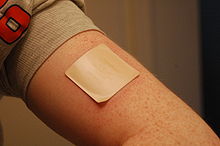Treatment and management of addiction
[1] Treatment of substance use disorders can start with detoxification if needed, to manage physical and psychological health when severe withdrawal symptoms are expected to occur.[22][24] Exercise may prevent the development of drug addiction by altering ΔFosB or c-Fos immunoreactivity in the striatum or other parts of the reward system.Therapeutic recreation can help an individual struggling with addiction to improve their self-esteem, confidence, motivation, resiliency, autonomy, enjoyment, and overall emotional state.[43] When access to varenicline and nicotine replacement therapy is limited (due to availability or cost), cytisine is considered the first line of treatment for smoking cessation.Use of replacement drugs increases the addicted individual's ability to function normally and eliminates the negative consequences of obtaining controlled substances illicitly.Vaccines tested on humans have been shown as safe with mild to moderate side effects, though did not have firm results confirming efficacy despite producing expected antibodies.[53] Vaccines which use anti-drug monoclonal antibodies (passive immunization) can mitigate drug-induced positive reinforcement by preventing the drug from moving across the blood–brain barrier.[54][55] As of November 2015[update], vaccine-based therapies are being tested in human clinical trials as a treatment for addiction and preventive measure against drug overdoses involving nicotine, cocaine, and methamphetamine.[57] Sociological research aims to pronounce the individual lived experiences of women receiving medication-assisted treatment (e.g., methadone, naltrexone, burprenorphine) in a long-term rehabilitation setting, through a twenty month long ethnographic fieldwork investigation.This person-centered research shows how the experiences of these women "emerge from stable systems of inequality based in intersectional gender, race, and class marginalization entangled with processes of intra-action.It is pointed out that "client bodies" as well as the "embodied experiences of self and social belonging emerge in and through the structures, temporalities, and expectations of the treatment centre.[65][66][63][64] These reviews and subsequent preliminary evidence which used oral administration or intraperitoneal administration of the sodium salt of butyric acid or other class I HDAC inhibitors for an extended period indicate that these drugs have efficacy in reducing addictive behavior in lab animals[note 2] that have developed addictions to ethanol, psychostimulants (i.e., amphetamine and cocaine), nicotine, and opiates.One line of gene therapy research involves the use of viral vectors to increase the expression of dopamine D2 receptor proteins in the brain.
addictionsubstance use disordersbehavioral addictionsproblematic gamblingsocial media addictiondetoxificationwithdrawal symptomstherapiescounselingcognitive behavioral therapy (CBT)medication-assisted treatmenttwelve-step programssupport groupsneurologicalbiotechnologydeep-brain stimulationsociologicalrelapsesabstinencetranstheoretical modelmetastudyrelapse preventioncommunity reinforcement approachContingency managementAddiction recovery groupsmarathon runningΔFosBimmunoreactivitystriataldopamine receptor D2AlcoholismAlcohol and healthLong-term effects of alcoholAlcoholopioidsphysical dependencedelirium tremensBenzodiazepinesalcohol withdrawalalcohol detoxificationnaltrexoneopioid antagonistdisulfiramacamprosatetopiramateBehavioral addictionpsychotherapypsychopharmacotherapyCognitive behavioral therapycompulsive behaviorCannabis addictionCB1 receptorβ-arrestin 2Transdermalnicotine replacement therapyNicotine addictionSmoking cessationTobacco harm reductionnicotinic receptor antagonistsnicotinic receptorpartial agonistsbupropionvareniclineCytisineOpioid use disorderOpioid epidemicbuprenorphineSuboxonenaloxonemethadoneopioid replacement therapymethadone clinicsDATA 2000dihydrocodeinedihydroetorphineheroinBaclofenalcohol withdrawal syndromedrug detoxificationoverdoseStimulant use disorderpharmacotherapyselective agonistsmonoclonal antibodiesblood–brain barrierglutamateGABAergicAMPA receptorsNMDA receptorsGABAB receptorsN-acetylcysteinemetabotropic glutamate receptorsadjunct therapyamphetamine-type stimulantshistone deacetylase inhibitorsoral administrationintraperitoneal administrationbutyric acidGene therapydopamine D2 receptorDrug rehabilitationhistone deacetylasehistone-modifying enzymesbutyrate saltssodium butyratetrichostatin Avalproic acidshort-chain fatty acidmedical indicationsmotivational anhedoniaself-administeredvalproateAmerican Journal of Public HealthKomisarukBibcodeReinforcementdependenceCocaineNicotineOpioidBehavioralGamblingShoppingPalatable foodIntercoursePornography